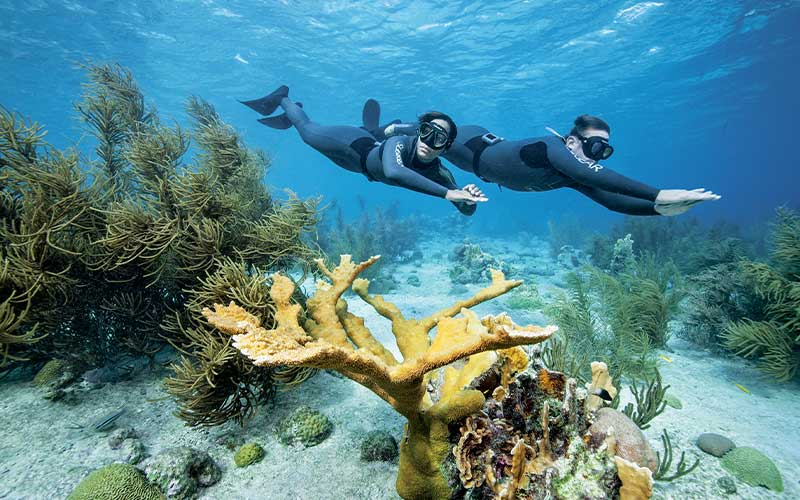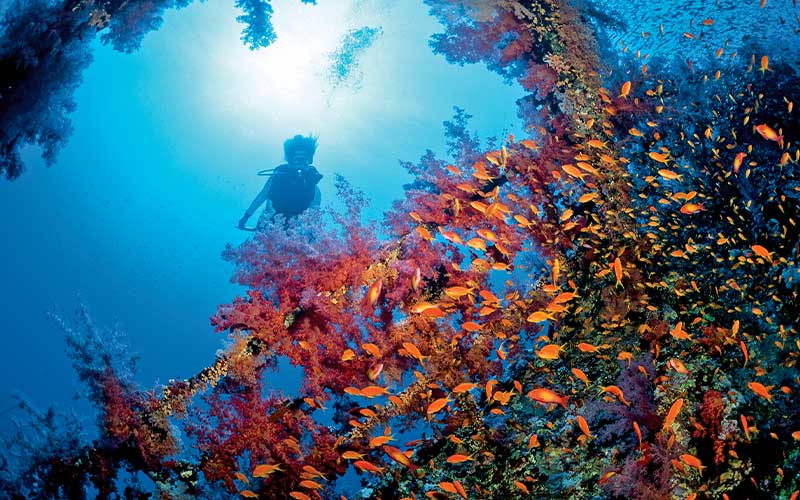It is rare for me to be on the other side of the lens in an underwater photo, but during a recent shark-photography event in the Bahamas, Mark Chapman captured an image of me with a tiger shark that was swimming away with my camera and strobe. It was a benign encounter — I swam along with the shark briefly until she discovered my strobe was not particularly edible and released it — but it made for a more striking image than a simple shark portrait. The presence of the diver in the photo adds a sense of scale, showing just how big and impressive this tiger shark was; it also makes for an interesting narrative.
Shots like this one require the photographer to be skilled and adaptable — able to catch a fleeting image of opportunity. But there is much more to working with models: It requires planning, collaboration and expertise with a wide-angle lens.
Underwater photography that features models may be of a commercial nature — to illustrate dive gear, for example. That’s the sort of photography Doug Perrine described as being a subset of fashion photography or product illustration, an observation I thought particularly astute. Images of models underwater might tell the story of a particular dive destination or adventure. Those are the kinds of images that launched my career as a dive journalist decades ago. I honed those skills during the 17 years I spent traveling the Florida Keys and the Caribbean for Skin Diver Magazine. “Diver in some kind of underwater environment” was my assignment.
Working with a dedicated model is much better than waiting in front of some scenic sponge and hoping for a diver to swim by as a chance element of composition. I’ve done the latter, but nothing beats a model who is ready and willing to work with you on a dive and understands your objectives. So how does one find such a person?
Recruitment
The obvious people to reach out to first are your significant other, your children and regular dive buddies or other friends. Both my wife and daughter have been excellent models for me over the years, which carries the advantage that we always get the opportunity to review together what worked and what didn’t and try to do it better the next time we work with each other. A willing dive buddy is a huge asset; one who you can work with repeatedly is ideal.
For commercial shoots we hire models, of course. With only a few days to shoot and a lot of products to illustrate, we can’t accept the risk of finding a willing model on the dive boat. Plus, products used in photo shoots are often the very first of their kind and likely aren’t available in every size, so the models must be hired according to size as well as physical appeal and appropriate age demographic.
As far as skills are concerned, the most important are comfort and facility in the water. Underwater models have to be able to position themselves in some very exact compositions and either hold position or move relative to marine life in the foreground. They must have excellent buoyancy skills so they appear comfortable and graceful in the water and can avoid contact with fragile corals even when proximity is required.

Modeling agencies are notorious for lying when describing the dive skills of their talent. It’s probably not malicious, but the booking agent is likely not a diver and typically won’t understand how crucial dive skills are to a successful underwater model shoot. Just being certified does not mean a model will possess the necessary skills. Unless the shoot is predominantly topside, years of experience underwater and an intuitive understanding of what the photographer is hoping to achieve make all the difference.
Compensation is also appropriate, but the level varies. With hired models there is an expected day rate in exchange for a model release. For dive buddies it may be something as simple as a complimentary photo they can post on Facebook. But at the very least there should be sincere thanks and appreciation for the skills of an underwater model — their contributions to this genre of photography can’t be overstated.
Communication
Unlike topside photography, underwater work requires the photographer to direct a model without speaking. Typically we discuss a complete set of underwater signals on the boat before the dive. I have signals for telling models when there is too much backscatter on the scene and it is time to move on, when we are shooting verticals or horizontals (as that will affect their posture in the water), how far or near they should position themselves relative to the reef or marine life in the foreground and optimal eye contact.
Eye contact is an extraordinarily important variable, as it directs the viewer’s eye when seeing the image. Rarely is there a reason for the model to stare directly into the camera; it’s much more natural for the model’s eye to be cast toward some underwater feature of interest. Most models will figure that out on their own, but if they don’t the photographer will need some signals to direct them. A lucky photographer will achieve some level of mind-meld with a talented model, as that makes the collaboration much more rewarding. But ultimately it is the photographer’s job to communicate where in the frame the model needs to be and what he or she is meant to do.
Wardrobe and Gear Preparation
In a catalog shoot, gear is paramount, and particular attention is given to logo placement and diver position relative to a preconceived layout. But in editorial photography compositions are less restrictive. In terms of wardrobe, it is nice to incorporate a bit of color, although that can be tough since so many wetsuits and BCs are black.
Masks and fins offer an opportunity for color coordination. Clear silicone skirts are much easier to light than black-skirted masks, and colorful fins add definition to divers in silhouette. It is especially important that masks be clear of fog, and new masks are particularly troublesome. The glass must be scrubbed thoroughly and repeatedly with toothpaste, Soft Scrub or some other product such as 500 PSI mask scrub. Both the glass and the inside of the silicone skirt need to be scoured; standard defogger isn’t usually up to the task for new masks.
Equally important is to tether the dive gear properly. Hoses should be clipped to the BC so they don’t dangle and damage coral — and create the psychological impression through the photo that it is appropriate to dive that way.
Execution
The density of water is important to remember with model photography, because strobe power diminishes rapidly with distance. A model more than eight feet away from a strobe-lit foreground will essentially be an element of composition and should be positioned accordingly. A strobe simply cannot punch through that much water, which is 800 times denser than air and of cyan color cast, so aiming a strobe toward a distant model will likely only create backscatter without appreciably illuminating the face mask or bringing in color from wardrobe. It would be better in that case to concentrate the strobe beam on an interesting element of the foreground.
However, when a model is within a couple of feet of the foreground or, for that matter, is the foreground, lighting the model is critical. The strobe should be directed so it doesn’t cast a shadow from the mask’s skirt or rim across the eyes. Caucasian hands and highly reflective bits of gear should not be too close to the beam of the strobe, as they’re easily overexposed.

Perspective should be considered as well, as whatever is nearest in a wide-angle photograph will appear larger than the background subject. That can be used to great effect with an already-large subject such as a whale shark. A snorkeler in the background will accentuate the immensity of the shark and make it appear even more impressive. Likewise, a soft-coral-festooned reef can be made even more captivating by using forced perspective with a wide-angle lens and artfully applying strobe light to highlight color and texture. However, perspective can work against you, too.
Years ago I shot a campaign for one of America’s largest ad agencies; one photo had a treasure diver ostensibly discovering a massive gold chain on the bottom near the wreck of the RMS Rhone in the British Virgin Islands to illustrate the concept “taste of success.” This was back in the days of film, so we didn’t see my shots until the next day, and the exposure, eye contact and background were all perfect to my eye. However, the art director wasn’t quite so pleased. He rather vociferously lamented, “These are the hands that ate Chicago!” Apparently he wasn’t used to seeing forced perspective in wide-angle underwater shots, so I had to go back the next day and reshoot. That time I made sure the hands were on the same plane as the body rather than outstretched toward me. A topside shooter might have shot the same scenario with a normal lens from 10 feet away, and all would have been perfect, but the underwater photographer (me) had to cover a subject as large as a diver from only three feet away and ensure maximum sharpness and color. The wide-angle lens, with its inherent optical characteristics, was the only solution.
So choose your models well, communicate clearly, and thank them. Make sure neither the photographer nor the model comes in contact with the coral, and determine the most important element to illuminate in the foreground. Consider how perspective distortion can work to your advantage, and, above all, don’t let your model’s hands eat Chicago!
© Alert Diver — Q4 Fall 2013